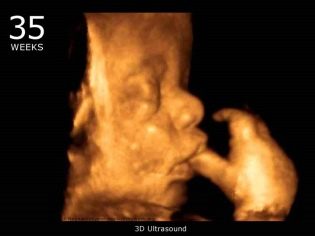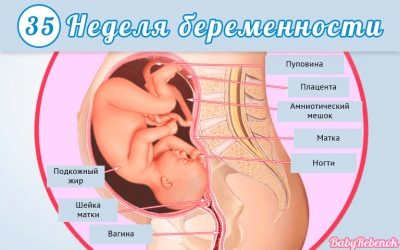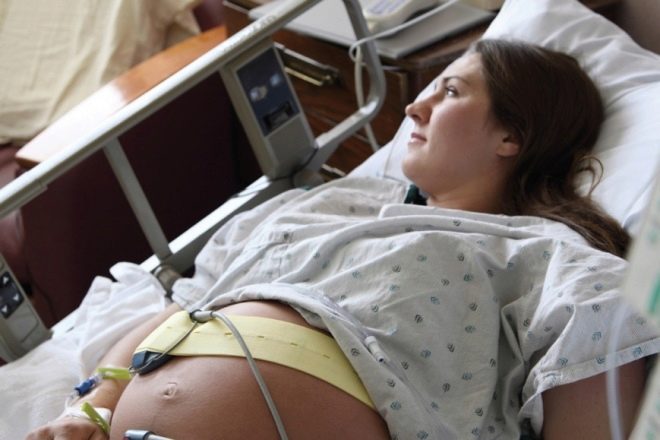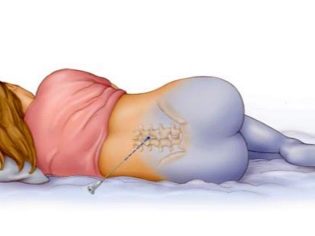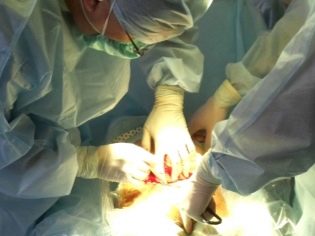Birth in the 35th week of pregnancy
At 35 weeks of pregnancy, childbirth can begin spontaneously, and can be stimulated by medical personnel according to certain indicators, in which the extension of pregnancy is impractical.
What are the features of birth at this time, what complications and risks they may be associated with, we will tell in this material.
Is this normal?
Normally, pregnancy lasts nine months in calendar terms, or ten months in the lunar period. In terms of obstetric weeks - 40 weeks. The closer the date of birth of the baby to the expected date of birth, so much the better for him and his momBecause the last weeks in the mother's womb are extremely important for the crumbs - it gains weight, “acquires” enough subcutaneous fat, so that after birth it is good to keep warm.
In the lungs is the formation of surfactant - a special substance that produces the alveoli of the lungs. It will not allow them to stick together after the first independent breath and will provide an opportunity to breathe air freely.
Birth at 40 weeks is a rather rare phenomenon. Most often, babies are born either earlier or slightly after the date determined by the midwives. But the concepts of "earlier" and "later" can not be approximate.
Urgent, that is completely normal, occurring on time, are considered childbirth, which occurs on one of the days between 37 obstetric weeks and 42 weeks. Naturally, the closer to 40 weeks, the better for mom and baby.
Births at 35 weeks for all standards in obstetrics are considered premature. This definition will be correct and accurate in the event that the generic process starts at 34-35 weeks, and in the event that the baby is born in full 35 weeks.
It should be said that among all premature births, according to medical statistics, 34-37 weeks account for the largest number of cases of early appearance of children. Up to 34 weeks, no more than 20% of “hastily” babies are born, up to 31 weeks - about 15%. And if in relation to the norm, childbirth at 35 weeks is pathological, then among all the categories of preterm labor, this period is considered one of the most favorable for future projections for the baby.
By this date, the child is fairly well formed, he has all the internal organs functioning, he has made certain reserves of subcutaneous fat, and according to the existing classification of prematurity, he is not considered a deep or seriously premature baby. However, there are some nuances, which will be discussed below.
The reasons
The reasons for the birth, which at this obstetric period will be stimulated by the doctor, may be either the extreme distress of the mother, or such a condition in the child. In most cases if necessary, save the lives of the child and his mom is assigned a caesarean sectionwhich is considered preferable in this situation.
The issue of early delivery is decided on the basis of certain grounds. There are a lot of them and they can be divided into maternal and fruit ones. In the first case, a woman may become aggravated with a serious chronic disease, for example, renal failure may develop, and another 2-3 weeks of pregnancy can simply kill both the woman and her unborn baby.
In the interests of the fetus, such a decision is often made in the event of a severe Rh-conflict, if the mother has a negative Rh factor in the blood, in a state of severe uncompensated fetal hypoxia, when it is not possible to maintain the pregnancy for at least another week due to the risk of fetal death.
The causes of spontaneous labor at this time may be more diverse. This includes the state of health of the mother, her chronic diseases, and the pathology of the current pregnancy, and the condition of the baby.
Here is just a partial list of reasons that can affect pregnancy and lead to preterm birth at 34-35 or 35-56 weeks:
- history of abortions and miscarriages;
- earlier surgery on the uterus;
- earlier the woman in labor already had early childbirth;
- high water flow;
- lack of water;
- violation of the permeability of the membranes of the fetal bladder, leakage of amniotic fluid or their discharge;
- functional imperfection of the cervix (cervical insufficiency);
- pre-oncological conditions of the cervix;
- placenta previa;
- genital infections;
- dangerous viral diseases transferred at the very beginning of pregnancy;
- heart disease;
- diabetes;
- preeclampsia with high blood pressure;
- genetic abnormalities of the fetus.
Also, childbirth at 35 weeks can occur due to adverse social conditions in which the pregnant woman is in - lack of adequate nutrition, alcohol and drug use, smoking, constant stress, hard work. At risk and women under the age of 18 years and after 40 years (late delivery is a special risk factor).
Birth at 35 weeks can women who are carrying twinsas well as pregnant women carrying a baby in pelvic presentation. Most often boys are born so early.
Features of the birth process
If childbirth begins prematurely, their management is somewhat different from normal delivery on time. In particular, need to come to the hospital as soon as possible, so that doctors have the opportunity to understand in detail what is happening and assess the situation. We need to weigh the risks for the woman and her baby to make the only right decision.
There are several possible options for further medical behavior: either they will not interfere in childbirth, choosing a waiting and observation tactic, or take an active participation and intervention position from the very beginning, or immediately decide on a cesarean section.
Preterm birth is dangerous because in 30% of cases they are accompanied by various complications, the process proceeds with pathologies and abnormalities.
Often, labor contractions, which should lead to complete disclosure of the cervix, are not strong and rhythmic, or too strong and fast. In the first case, the primary weakness of the tribal forces develops, in the second - rapid or rapid delivery.
If you find such a problem drugs are administered to the woman - either increasing uterine activity and relaxing the muscles of the cervix, or, conversely, slowing contractionsif there are prerequisites for fast or rapidly flowing childbirth.
In the process of preterm labor, epidural anesthesia is allowed to be applied according to the situation. In addition, many women in labor who give birth before the onset of obstetric terms are given an episiotomy (surgical dissection of the perineum) during childbirth.
A cesarean section for life-saving indications is carried out if independent deliveries pose a danger to the child and mother. Most often in cases where there is severe oxygen starvation of the fetus, entanglement with an umbilical cord with asphyxiation, placental abruption, loss of umbilical cord loops and body parts of the child beyond the uterus into the birth canal, which is possible with rapid discharge of water.
Risks and potential consequences for the child
As already mentioned, a sufficient amount of surfactant is formed in the lung tissue of a fully-term baby. If the generic process started ahead of time, then there is a risk that the amount of surfactant will be insufficient for proper breathing, respiratory failure will develop. It is she who ranks first among the causes of infant mortality as a result of premature birth.
Today, with the development of resuscitation care, the opportunity has arisen to save such children, but the percentage of mortality still remains quite high.
Acute respiratory distress syndrome develops abruptly, suddenly after the crumbs of the first breath. The syndrome is manifested by suffocation, acute oxygen deficiency. A child can be saved by urgently giving him resuscitation care - to connect the baby to the ventilator. The doctors' forecasts are ambiguous, nobody can guarantee in advance that the baby will be able to breathe on his own. In addition, a long stay on the ventilator and probe feeding create the risk of infection of the respiratory tract, which can also cause a deterioration of the baby’s condition.
In the state of hypoxia, the brain cells are destroyed very quickly, since this organ is one of the first to respond to a lack of oxygen. Therefore, no one will be able to assess the consequences of the distress syndrome as well. They will depend on the degree of brain damage, on the reversibility of these processes.
Brain disorders in premature babies are recorded more often than in full-term babies, not only because of distress syndrome. The brain structures themselves at 35 weeks are not as mature as those of a fetus at 38, 39, or 40 weeks. Sometimes there are cases of cerebral strokes immediately after birth, in childbirth or a few hours after them.
It is not possible to evaluate in advance how a hemorrhage in the brain will manifest itself. The degree, depth, location and size of hematomas are of paramount importance in this matter. The consequences can later be manifested by unexpressed weak neurological disorders, and can lead to severe mental disorders, paralysis, damage to the central nervous system, impaired hearing and vision.
If childbirth in the 35th week of pregnancy occurs naturally, the risks of injury to the baby are also considered elevated. Due to the relative lack of maturity of the nervous system, the biomechanical processes of childbirth can be disrupted, as a result of which the cervical vertebrae and other parts of the spine can be injured.
If, moreover, the birth proceeds quickly, then the probability of birth injury increases several times.
To reassure women, it should be noted that the likelihood of severe consequences for a child born at 30 weeks is much higher than for a baby who is born at 35-36 a week. Therefore, one must believe in the best.
An important factor for a baby is its weight at birth. Average statistics says that at 35 weeks, children weigh an average of about 2500-2700 kg. This is ample weight.so that the child after birth can retain body heat so that thermoregulation disorders do not occur. However, the situations may be different, and the weight of some babies at this time does not reach 2 kilograms. So kids will definitely need resuscitation care.
According to the classification of the degree of prematurity, children born on week 35 belong to the second group. The first is considered the most diagnostically favorable, but it includes babies born at 36-37 weeks. The second group is more unpredictable. But there are also the third and fourth groups, in which the child is considered difficult and extremely difficult, and therefore giving birth in the 35th week of pregnancy is not as good as the doctors and the woman would have liked, but not as bad as it could be, be born baby a couple of weeks earlier.
Externally, the newborn is slightly different from full-term babies. The main difference is height and weight, the cheeks will be less plump, there can be a residue of lanugo on the skin. The child has all the necessary reflexes - he can suck and swallow, and if his birth is not accompanied by distress syndrome or other complications, then the child can be immediately applied to the chest.
Most of the children who appeared at the 35-36 week, can not only survive, but also grow up healthy to the joy of mom and dad. True, the first days after birth, these babies are still carried out under the control of neonatologists and resuscitators in a special heated bed.
Danger to woman
A woman who had to give birth to a child at 35 weeks can be threatened by various postpartum complications, the likelihood of which after early childbirth is always increased.
In such women more often than in others, gaps in the genital tract and perineum are recorded. Often injured cervix. With all these conditions, the obstetric team is able to cope in the labor hall, but recovery for the birth of the baby will take, for obvious reasons, more time.
The basic risks of infectious and inflammatory complications after childbirth are slightly higher.
The recovery period can be darkened by long healing of the seams in the perineum, as well as problems with the contractility of the uterus.
Often, after preterm labor, women develop postnatal depression, which is very dangerous, given that the premature baby requires special care and care throughout the first year of life.
Reviews
According to reviews of pregnant women whose children were born at 35 weeks of pregnancy, most often babies were born with a weight of 2500-2600 g. They did not bring the baby right away, some were brought to the baby two days later, and some later. In a maternity hospital with such babies, women usually spend longer periods of time write them out either on day 8-12 (full-term babies - on the 3rd day), or transferred to a children's hospital.
Even mothers whose children have long been in intensive care on a medical ventilator claim that no long-term effects are detected in children. They grow and develop according to age norms.
Problems with lactation after delivery in this period usually does not happen. Milk comes 2-3 days after the birth of a baby and its quantity and quality do not suffer from the fact of premature birth.
Learn more about caring for premature babies in this video.


